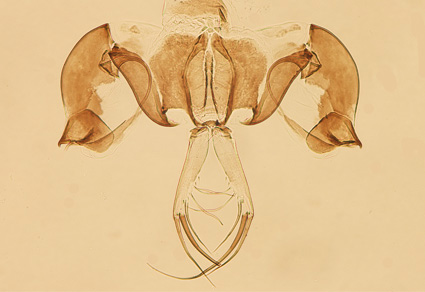Abstract
The chaetotaxy and microstructure of the furca were examined in three interstitial and one epifaunal species of the ostracod genus Neonesidea (Podocopida: Bairdioidea). Of the seven setae found on the furcae of the examined species, the thick and curved first to third setae from the distal end were relatively long and had two rows of serrations. The fourth and fifth setae, with intermediate lengths, were covered by numerous setulae of varying lengths and orientations. The sixth and seventh setae were shortest, with setulae and openings at the tips. These morphological variations suggest functional differences, that is the furca does not only have a mechanoreceptor function, but also a chemoreceptor function according to the direction of the setulae and the openings at the tips. Specific and sexual differences were observed when comparing the relative lengths of the seven setae on the furca. In contrast, there were no noticeable furcal characteristics that distinguished the three interstitials from the epiphytic species examined here.
References
- Asaba, E., Asaba, R. & Tsukagoshi, A. (2024) Three new interstitial species of the genus Neonesidea (Bairdioidea: Podocopida: Ostracoda) from the infralittoral zone in Japan. Zootaxa, 5397 (3), 377–396. https://doi.org/10.11646/zootaxa.5397.3.4
- Athersuch, J., Horne, D.J. & Whittaker, J.E. (1989) Marine and Brackish Water Ostracods. Synopses of the British Fauna. New Series. No. 43. E.J. Brill, Leiden, 343 pp. https://doi.org/10.1163/9789004627666
- Bowman, T.E. (1971) The case of the nonubiquitous telson and the fraudulent furca. Crustaceana, 21, 165–175. https://doi.org/10.1163/156854071X00373
- Felgenhauer, B.E., Watling, L. & Thistle, A.B. (Eds.) (1989) Functional Morphology of Feeding and Grooming in Crustacea, Crustacean Issues 6. A.A. Balkema, Rotterdam, 225 pp.
- Hiruta, S. (1994) Two new marine interstitial Ostracoda (Crustacea: Pussellidae) from Fiji. Proceedings of the Biological Society of Washington, 107, 657–665.
- Horikoshi, H., Nakao, Y. & Tsukagoshi, A. (2019) Two new species of Bairdiidae (Ostracoda: Crustacea) from the western Pacific coast of Japan. Zootaxa, 4679 (3), 450–462. https://doi.org/10.11646/zootaxa.4679.3.2
- Horne, D.J., Cohen, A. & Martens, K. (2002) Taxonomy, morphology and biology of Quaternary and living Ostracoda. In: Holmes, J.A. & Chivas, A.R. (Eds.), The Ostracoda – Applications in Quaternary Research. American Geophysical Union Geophysical Monograph 131. The American Geophysical Union (AGU), Washington, D.C., pp. 5–36. https://doi.org/10.1029/131GM02
- Ito, M. & Tsukagoshi, A. (2022) Two species of the genus Anchistrocheles (Bairdioidea: Ostracoda: Crustacea) from Japan and their developmental characteristics for adaptation to interstitial environments. Zootaxa, 5194 (1), 71–91. https://doi.org/10.11646/zootaxa.5194.1.4
- Kornicker, L.S. & Sohn, I.G. (1976) Phylogeny, ontogeny, and morphology of living and fossil Thaumatocypridacea (Myodocopa: Ostracoda). Smithsonian Contributions to Zoology, 219, 1–124. https://doi.org/10.5479/si.00810282.219
- Maddocks, R.F. (1969) Revision of Recent Bairdiidae (Ostracoda). United States National Museum Bulletin, 295, 1–126. https://doi.org/10.5479/si.03629236.295.1
- Maddocks, R.F. (1982) Evolution within the Crustacea: Part 4: Ostracoda. In: Abele, L.G. (Ed.), The Biology of Crustacea. Vol. 1. Systematics, the Fossil Record and Biogeography. Academic press, San Diego, California, pp. 221–234.
- Maddocks, R.F. (2015) New and poorly known species of Bairdoppilata and Paranesidea (Bairdiidae, Ostracoda) from French Frigate Shoals and O’ahu, the Hawaiian Islands. Zootaxa, 4059 (2), 277–317. https://doi.org/10.11646/zootaxa.4059.2.3
- Maddocks, R.F. (2022) Taxonomic applications of the esophageal flapper valve in Bairdoppilata and Glyptobairdia (Bairdiidae, Ostracoda), with comments on anatomy, ontogeny, and geography. Zootaxa, 5175 (3), 301–342. https://doi.org/10.11646/zootaxa.5175.3.1
- Matzke-Karasz, R., Nagler, C. & Hofmann, S. (2014) The ostracod springtail – camera recordings of a previously undescribed high-speed escape jump in the genus Tanycypris. Crustaceana, 87, 1072–1094. https://doi.org/10.1163/15685403-00003343
- Meisch, C. (2007) On the origin of the putative furca of the Ostracoda (Crustacea). Hydrobiologia, 585, 181–200. https://doi.org/10.1007/s10750-007-0637-2
- Parker, A.R. (1997) Functional morphology of the myodocopine (Ostracoda) furca and sclerotized body plate. Journal of Crustacean Biology, 17, 632–653. https://doi.org/10.1163/193724097X00062
- Schram, F.R. (1986) Crustacea. Oxford University Press, England, 606 pp.
- Smith, R.J. & Kamiya, T. (2002) The ontogeny of Neonesidea oligodentata (Bairdioidea, Ostracoda, Crustacea). Hydrobiologia, 489, 245–275. https://doi.org/10.1023/A:1023221303564
- Smith, R.J. & Kamiya, T. (2008) The ontogeny of two species of Darwinuloidea (Ostracoda, Crustacea). Zoologischer Anzeiger, 247, 275–302. https://doi.org/10.1016/j.jcz.2008.05.002
- Tsukagoshi, A. (1988) Reproductive character displacement in the ostracod genus Cythere. Journal of Crustacean Biology, 8, 563–575. https://doi.org/10.1163/193724088X00413
- Tsukagoshi, A. & Parker, A. (2000) Trunk segmentation of some podocopine lineages in Ostracoda. Hydrobiologia, 419, 15–30. https://doi.org/10.1023/A:1003981806643
- Vannier, J. & Abe, K. (1993) Functional morphology and behavior of Vargula hilgendorfii (Ostracoda: Myodocopida) from Japan, and discussion of its crustacean ectoparasites: preliminary results from video recordings. Journal of Crustacean Biology, 13, 51–76. https://doi.org/10.1163/193724093X00444
- Vannier, J. & Abe, K. (1998) Feeding in myodocopid ostracods: functional morphology and laboratory observations from videos. Marine Biology, 132, 391–408. https://doi.org/10.1007/s002270050406


